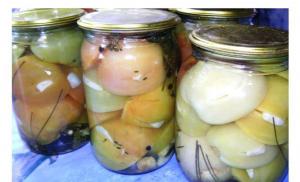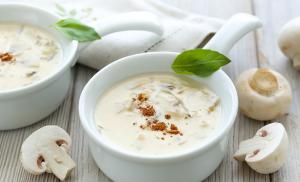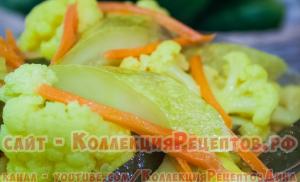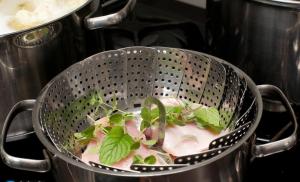Vegetables marinated in Korean style.
Today I will show you a recipe for making Korean pickled vegetables.
This is a very tasty and aromatic sweet, sour, spicy snack.
And since the marinade contains turmeric, the vegetables turn out a beautiful bright yellow color.
This recipe is very simple and quick, but you need to prepare it in advance, because... vegetables must be infused.
To prepare pickled vegetables in Korean we will need:
List of ingredients:
- 2 kg. vegetables (cauliflower, white cabbage, zucchini, cucumbers)
- carrots 2 pcs.
- garlic 2 heads
For the marinade:
- 1 liter of water
- 150 gr. sugar (2/3 cup)
- 2 tbsp. salt (60 gr.)
- 100 ml. vegetable oil
- 100 ml. 9% vinegar
- peppercorns
- Bay leaf
- 1 tsp turmeric
Korean-style vegetables - step-by-step recipe:
First, let's prepare the marinade.
Pour water, vinegar, vegetable oil into a small saucepan, add sugar, salt, add peppercorns and bay leaves, as well as turmeric.
Mix everything well and put it on the stove to let the marinade boil.
Separately, we will need a pan of boiling water for blanching vegetables, put the pan of water on the stove and let it boil.
While the marinade and water are boiling, prepare the vegetables.
Cut the garlic into small pieces, transfer to a bowl and set aside for now.
Let's take care of the cucumbers, cut the cucumbers into cubes, at least a centimeter thick and put them in a separate bowl.
Without peeling, cut young zucchini or zucchini, as well as cucumbers, diagonally into cubes and pour into another bowl, because... Blanch the vegetables separately from each other.
Next we take white cabbage, which we cut into large pieces; if the cabbage is young, you don’t have to remove the stalk.
Pour the carrots into a separate bowl and now move on to the cauliflower.
We disassemble the head of cabbage into inflorescences. Leave the small ones whole, cut the large ones into pieces.
All products are prepared, let's go to the stove and blanch the vegetables
While we were chopping, the marinade and water came to a boil, reduce the heat under the marinade to low, and pour the cauliflower into boiling water and blanch for 2 minutes.
After 2 minutes, take the cabbage out of the boiling water and transfer it to a saucepan in which we will marinate our vegetables.
Sprinkle the cabbage with chopped carrots and garlic, and in the meantime the water has boiled again, pour the zucchini into it and also blanch for 2 minutes.
In this recipe, you can use one type of vegetable or, as in my case, assorted vegetables, it’s all at your discretion.
2 minutes have passed, we take out the zucchini and place them in the pan with the cauliflower.
Sprinkle again with chopped carrots and garlic.
Sprinkle with chopped carrots and garlic.
All that remains is to blanch the white cabbage, repeat the same procedure.
Sprinkle the cabbage with the remaining carrots and garlic.
Pour the boiling marinade over the prepared vegetables, compact them slightly so that they are completely covered with it.
Leave the pan with vegetables on the table until it cools completely, and then put it in the refrigerator, let it sit at least overnight, but preferably for a day.
A day later, take the pan out of the refrigerator.
Our Korean pickled vegetables are ready!
As you noticed, preparing this appetizer is easy and quick.
Despite heat treatment, vegetables remain crispy and at the same time retain their beneficial properties.
This is a sweet and sour low-calorie snack with a pleasant garlic aroma; it will appeal to all lovers of salads and Korean appetizers.
The vegetables turn out so tasty that you simply can’t stop eating them.
This appetizer can be prepared all year round and is perfect for any holiday table.
Try it too, I wish you all a bon appetit!
In order not to miss new, interesting video recipes - SUBSCRIBE to my YouTube channel Recipe Collection👇
👆Subscribe in 1 click
Dina was with you. See you again, see you new recipes!
Korean-style vegetables - video recipe:
Korean-style vegetables - photo:


























Try my simple homemade Korean vegetable recipe. An appetizer made from Chinese cabbage, lettuce peppers and carrots is not only very tasty, spicy and juicy, but also delicious to look at. Fresh and tender green leaves of Chinese cabbage harmonize in color with yellow salad peppers and bright orange carrots. This cute vegetable platter can be served for a holiday table or a simple home-cooked dinner. I think that such a savory snack will not be superfluous. Step-by-step photos make the recipe clear and the preparation simple.
Products:
- Chinese cabbage – 2 kg;
- carrots – 800 gr;
- salad pepper – 600 gr;
- garlic – 1-2 heads.
- vegetable oil – 100 g;
- vinegar – 50 ml;
- granulated sugar - 50 g;
- salt – 15 g;
- ground coriander – 2 tsp;
- ground red pepper – ½ tsp;
- ground black pepper – 2 tsp.
To prepare our spicy vegetable snack, it is better to purchase a fairly large head of Chinese cabbage. The larger the cabbage, the juicier and tastier it is. Also make sure that the head of cabbage is undamaged (the leaves are intact and green).
For such salads, I always choose sweet and juicy varieties of carrots such as “karotel” or “sweet tooth”.
Choose salad peppers that are juicy and meaty.
How to cook vegetables in Korean
We need to wash the salad pepper, and then cut the pepper in half and remove its seeds and stem. Then simply cut the pepper halves into thin strips.


Then we chop the Chinese cabbage into strips the same size as we cut the lettuce pepper.

We need to wash the carrots in running water to remove any adhering soil and then peel them (preferably using a vegetable peeler). Then grate the carrot on a Korean carrot grater.

We need to peel and chop the garlic.
Place the pekin, garlic, lettuce and carrots in a large bowl, add spices (two types of pepper, salt and coriander), sugar, vinegar and vegetable oil.

Next, our vegetables in Korean need to be mixed thoroughly. I usually mix (but do not mash) vegetables for about five minutes, and always with my hands, not with a spoon, this way you can better feel whether the salt and sugar have completely dissolved.

After this, put the assorted vegetables in a glass jar and let it brew for two hours before serving.

Usually during this time the Korean-style vegetables have time to marinate properly. Then the snack should be stored in the refrigerator in a closed container for no more than two weeks.

The Korean-style vegetables turned out juicy, moderately spicy, and, as I promised, very appetizing. Serving this appetizer of Chinese cabbage, lettuce peppers and carrots is appropriate for any meal.
The basis of Korean cuisine is spices and sauces. Real Asian dishes are not just spicy, but literally burn all the taste buds, forcing them to work at full capacity. Moreover, not only meat dishes, but also vegetable salads should be hot, although Europeans have already altered many of them to their taste. Let's look at the most popular and delicious Korean vegetable salads below.
with mushrooms
To prepare Korean carrots for this recipe, you will need a special grater, or you will have to chop the orange vegetable by hand. In total, you will need two grated carrots (0.4 kg), which must be placed in a glass bowl for pickling. Then pour vinegar, add salt and sugar (1 teaspoon each), mix the ingredients thoroughly and place the container with the salad in the refrigerator for 15 minutes.
After the specified time, when more juice appears in the carrots, add black and red pepper to the salad to taste. Heat sunflower oil (3 tablespoons) well over low heat, then carefully pour it into a container with carrots and mix. When the oil has cooled, add squeezed garlic (3 cloves) and pickled mushrooms (100 g) to the salad. Mix the vegetables well again in Korean style, put the bowl in the refrigerator for 10 hours, after which you can try the salad. Store the finished dish in the refrigerator for no more than two weeks.
Beets in Korean
According to this recipe, raw beets (1 kg) are grated on the same grater as Korean carrots. Then it is put in a bowl and seasoned with marinade. To prepare it, you need to mix a teaspoon of hot and black pepper, paprika and coriander, a tablespoon of sugar, garlic squeezed through a press (6 cloves), apple and (1.5 tablespoons each), vegetable oil (3 tablespoons) . Mix the Korean vegetables well and place the bowl of salad in the refrigerator for at least 6 hours. After the specified time, the beets can be tasted.

Korean-style vegetables according to the recipe proposed above have a rich, spicy-sweet taste. These beets can be served as a side dish for meat.
Korean cabbage salads
Healthy Chinese cabbage is often used in Korean dishes. It is used to prepare such delicious Korean salads as “Kimchi” and cabbage with saffron.
For the Kimchi salad, forks of Chinese cabbage must be disassembled into leaves, after which each of them must be cut into random pieces. Then add salt (3 tablespoons) and mix with the leaves. Cover the bowl with film and place the salad in the refrigerator for 24 hours.

After a day, drain the water from the cabbage, add chili peppers cut into long strips (one red and one green), garlic (2 cloves), green onions and grated ginger root. Season the salad with soy sauce (5 tablespoons each), adding paprika and sugar (2 tablespoons each). Add enough chilled boiled water to the bowl with the salad to cover the cabbage. After this, cover the container with film and put it in the refrigerator for three days.
Korean marinated zucchini
For this dish you will need young zucchini (5 pieces) with tender pulp, thin skin and small seeds. They are washed well, doused with boiling water and cut lengthwise into thin and long strips using a potato peeler. Place the zucchini in a glass bowl (saucepan) in which they will marinate. At this time, pour vegetable oil (40 ml), salt, sugar (1 teaspoon each), and ground coriander (2 teaspoons) into a separate container. Heat the mixture a little on the stove, then remove it from the heat, pour in vinegar (40 ml) and add garlic (3 cloves).

Pour the resulting marinade over the zucchini, add fresh chopped herbs to taste, mix and refrigerate for 12-14 hours.
According to this recipe, Korean pickled vegetables are moderately spicy. All lovers of fiery snacks are advised to add fresh or dried red pepper to the marinade.
Korean-style vegetables: winter recipes
In Korean cuisine, eggplants are often used in cooking. They are used to prepare fresh salads or Korean-style canned vegetables for the winter. The recipes of this Asian cuisine are widely used by our housewives.
To prepare Korean eggplant, vegetables (1 kg) need to be washed, pricked with a fork in several places and boiled in salted water for 5 minutes. Then remove the eggplants from the pan and put them under pressure so that all the water leaves them. The liquid must be drained periodically. After 6 hours, the eggplants need to be cut into strips, as well as sweet peppers (100 g), and the carrots (1 piece) should be grated (as in the Korean recipe). Place all the vegetables in one bowl, add a marinade of vegetable oil and vinegar (100 ml of each ingredient), a teaspoon of salt, a tablespoon of sugar and 10 g of Korean seasoning (as for carrots). Mix the salad and place in jars. Korean-style vegetables must be pasteurized for 15 minutes before rolling up the lids.
Delicious vegetable salads with meat
Recipes for vegetable salads with the addition of meat are no less popular in Korean cuisine. Not only do they taste better than vegetarian dishes, but they also have higher nutritional value. Below we describe how Korean salads are prepared (step-by-step recipes).
- Korean fried cucumber salad with beef.
This is one of the most popular salads in Korean cuisine. Even those people who do not eat fresh green vegetables like the taste in this dish.

For this dish you will need ground beef, fried with spices. Place 150 g of minced beef in a non-stick frying pan. Immediately after this, add to it: soy sauce, sugar and rice cooking wine (2 teaspoons each), sesame oil (1 teaspoon), a clove of chopped garlic and black pepper (¼ teaspoon). Fry the minced meat until cooked. If desired, you can add some fried mushrooms to the pan, which harmonize perfectly with the taste of beef.
Fresh cucumber must be marinated in salt before frying. To do this, cut it into rings 3 mm thick and mix with salt (for 100 g of cucumbers you need to take 1 teaspoon of salt). After 7 minutes, the juice released by the cucumbers must be squeezed out. Add the vegetables themselves to the meat and fry in a pan for two minutes. Sprinkle the finished dish with sesame seeds.
- Carrot salad with pork.
For this salad, carrots (1 kg) are grated on a special grater (as for the Korean recipe) and rubbed by hand with salt, black and red pepper and soy sauce (1 tablespoon). While the carrots are marinating in a frying pan, you need to fry the onion, chopped into half rings, and the pork, cut into thin slices. Then mix the meat with carrots, season with sweet syrup (from 1 tablespoon of sugar and 2 tablespoons of water) and crushed garlic (2 cloves). Korean-style vegetables and meat must be thoroughly mixed and refrigerated for 3-4 hours. After the specified time, the dish can be served.
Korean-style eggplant salad "Kadi-he"
Heh is a popular Korean dish made from fresh fish and onions with the addition of hot red pepper, soy sauce and vinegar. However, anyone who doesn’t like fish snacks can be offered another heh recipe, but with eggplant. The different Korean vegetables in this salad are in perfect harmony with each other in taste and color. This salad can be served as an appetizer on a holiday table.

According to the recipe for this dish, you first need to cut the eggplants into thin strips and remove the bitterness from them. To do this, they need to be sprinkled with salt and refrigerated for 2-3 hours. After this, the resulting liquid must be drained, squeeze out the eggplants and fry in vegetable oil in small portions.
While the fried vegetables are cooling, you need to cut the bell pepper (2 pcs.), carrots and onions into strips. Add the following spices to the vegetables: coriander (ground), black and red hot pepper (2 teaspoons each), 4 cloves of garlic, sesame seeds, honey (1 tablespoon) and apple cider vinegar (3 tablespoons). After this, transfer the eggplants to the salad, mix, cover with film and put in the refrigerator for a day. After the specified time, the salad can be served.
As you can see, preparing delicious salads in Korean is not at all that difficult.
Vegetables, Korean marinated, are prepared quite simply. The biggest difficulty is maintaining the marinating time. Vegetables prepared in this way are natural, tasty and aromatic. They go well with any fish and meat dishes. It's also the perfect meatless meal.
Recipe for vegetables marinated in Korean style.
Ingredients:
- carrots, sweet bell pepper – 200 g each
- white cabbage – 1 kg
- fresh cucumbers – 220 g
- vinegar – 220 ml
- water – 1 liter
- sugar – 320 g
- salt – 55 g
Preparation:
1. Peel and rinse the vegetables.
2. Cut the cabbage into cubes, carrots, cucumbers and peppers into sticks using a curly knife.
3. Place carrots and cabbage in a bowl, pour boiling water over them, leave for a few minutes.
4. Prepare the marinade: mix water, vinegar, sugar and salt. Place the carrots and cabbage in a large bowl, add the rest of the vegetables, pour in the marinade, stir, and leave to marinate for a day.
Korean pickled cabbage.
Ingredients:
- Chinese cabbage – 1 head
- salt
- garlic cloves – 5 pcs.
- water – 2 liters
- a pod of hot hot pepper
Preparation:
1. Wash the cabbage, cut in half.
2. Dissolve salt in water to form a saline solution. Place the cabbage halves into the resulting solution and soak them for 24 hours. You can soak it more, the main thing is that the cabbage is thoroughly softened and the leaves lose their fragility.
3. Prepare the spicy filling: mince the pepper and garlic several times, lightly salt it, and keep the mixture in the refrigerator for 24 hours.
4. Bending the cabbage leaves, grease them on both sides with the spicy mixture, then place the cabbage under pressure for 2 days.

Try also.
Tomatoes marinated in Korean style.
Ingredients:
- fresh tomatoes – 1 kg
- sweet pepper – 2 pcs.
- head of garlic
- vegetable oil – 55 g
- sugar – 55 g
- vinegar – 50 ml
- salt - tablespoon
- carrots – 1 pc.
- dill
- parsley
- ground red pepper

Preparation:
1. Wash the tomatoes and cut them in half.
2. Grind sweet peppers and garlic through a meat grinder and mix well.
3. Grate the carrots and chop the greens.
4. Place in a jar in layers - tomato halves, cut side up, garlic and pepper, carrots, herbs.
5. After 2-3 layers, sprinkle with red ground pepper. You can also add any spices.
6. Prepare a cold marinade: mix vinegar with oil, salt and sugar until the ingredients dissolve.
7. Pour the marinade over the tomatoes, close the jars with a lid, and place them in the refrigerator, turning them over.
8. After 8 hours, tomatoes can be eaten.
Korean salads, despite their spiciness and specificity, have become incredibly popular in different countries of the world. Today it is difficult to imagine that our housewives could once do without Korean carrots or vegetables, because they are the basis for many dishes that we serve to our guests.
Korean salads are prepared not only from raw, but also from pickled, pickled and boiled vegetables. The main components of the salad are often supplemented with mushrooms, fish or meat.
The main secret of oriental salads is hot seasonings and soy sauce. For example, the specific taste of Korean carrots is created using red peppers, which are roasted over a fire and then quickly cooled. Without heat treatment, such pepper would be almost unfit for food for a European, but the thermal effect “eats” the heat and adapts the pepper to the European taste.
Korean salads - food preparation
When starting to prepare Korean salads, be prepared for the fact that preparing the ingredients will take a lot of time. To speed up this process, it is better to acquire a special grater or slicer in advance (usually food processors include an element for slicing Korean carrots). If you don't have a grater, learn how to cut carrots into long, thin strips.
Before chopping, keep the vegetable in cold water for several hours, in which case it will become much easier to work with. It is important that the vegetables are cut into equal pieces or strips, in which case they will marinate or fry evenly.
Under no circumstances leave carrots or other pickled vegetables in enamel dishes; the food will taste metallic, which certainly will not decorate the dish.
Recipe 1: Korean carrots
Korean carrots are an excellent appetizer, a side dish for meat, and an ingredient for many salads.
Ingredients:
- 1 kilogram of carrots;
- 4 cloves of garlic;
- 1 teaspoon coriander;
- 1 tablespoon of vinegar;
- 1 tablespoon of salt;
- ground black pepper;
- ground red pepper;
- vegetable oil;
- water.
Cooking method
Three carrots on a grater. Prepare the vegetable dressing: 6 tablespoons of water, finely chopped garlic, vinegar, salt, pepper (red and black), coriander, vegetable oil, boil, mix with carrots, put in the refrigerator for 1-1.5 hours.
Korean carrots are ready!
Recipe 2: Korean beets
Korean-style beets are a wonderful appetizer; they are easy to prepare and also quickly disappear from the holiday table.
Ingredients:
- 500 grams of red sweet beets;
- 3 cloves of garlic;
— 100 grams of vegetable oil;
- 70 milliliters of vinegar;
- 1 teaspoon ground coriander;
- 1/2 teaspoon red pepper;
- 1/2 teaspoon of monosodium glutamate flavor enhancer;
- salt.
Cooking method
Three beets on a grater. Finely chop the garlic or pass it through a garlic press, add it to the beets, add vinegar and salt. The vegetable should be placed in such a container that you can make a water bath, cook for half an hour. Remove from heat and add remaining seasonings. Heat the vegetable oil (no need to boil!), pour it over the beets. We put the beets under pressure in Korean and keep them for 24 hours.
Recipe 3: Korean Vegetables
A wonderful salad that will complement the holiday table in winter and summer.
Ingredients:
- 1.5 kilograms of white cabbage;
- 1.5 kilograms of carrots;
- 1 kilogram of bell pepper;
- 1 kilogram of onion;
- 2 heads of garlic;
- 1 teaspoon black pepper;
- 1 teaspoon red pepper;
— 2 packs of seasoning for Korean carrots;
- 1 piece of hot pepper;
- 6 tablespoons of sugar;
— 1 glass of vegetable oil;
- 1 glass of vinegar;
- 2.5 tablespoons of salt.
Cooking method
Grate the vegetables, chop them, cut them into strips. Add salt, sugar, pepper (red and black), vinegar, carrot seasoning. Pour vegetable oil (1 cup) into a frying pan and fry finely chopped onion in it. Grind garlic and capsicum through a meat grinder. Mix all ingredients. The salad can be eaten immediately or rolled into jars and enjoyed in winter.
Recipe 4: Korean salad “Kadi-he”
Traditional Korean dish.
Ingredients:
- 800 grams of eggplants;
- 1/2 kilogram of cucumbers;
- 300 grams of tomatoes;
- 3 bell peppers;
- 1 onion;
- 4 cloves of garlic;
- 1 chilli red pepper;
- 1 tablespoon of soy sauce;
- 1/2 cup vegetable oil;
- 1/2 teaspoon ground black pepper;
- 1/2 teaspoon ground red pepper;
- a few drops of vinegar;
- greenery;
- salt.
Cooking method
Cut the eggplants into 2-4 parts, boil for several minutes in salted water (it is very important not to overcook). Transfer the eggplants from hot water to cold water, let stand for a few minutes, and squeeze. Cut the boiled eggplants into small cubes, add chopped onions, bell peppers, tomatoes, cucumbers, add chopped garlic, herbs, spices, soy sauce, vegetable oil and vinegar.
Carrots for Korean salads need to be fresh and fairly large in size (make sure they are not “wooden”). If chicken is used in the dish, it should be boiled and separated into fibers. Wash parsley for salads with warm water, not cold, so it will better retain its flavor.













